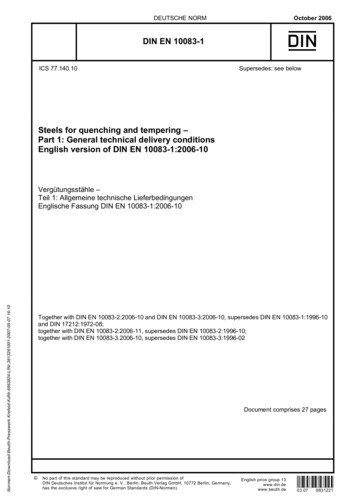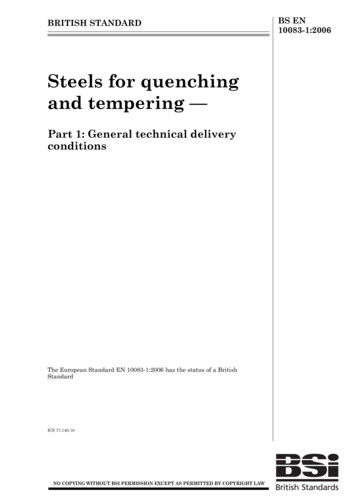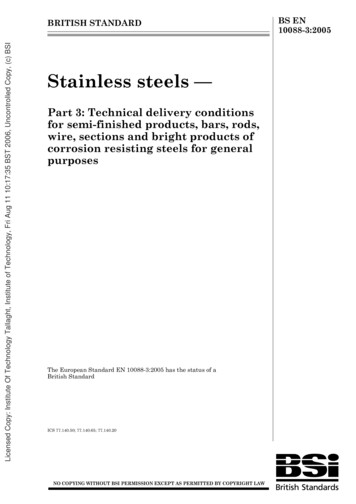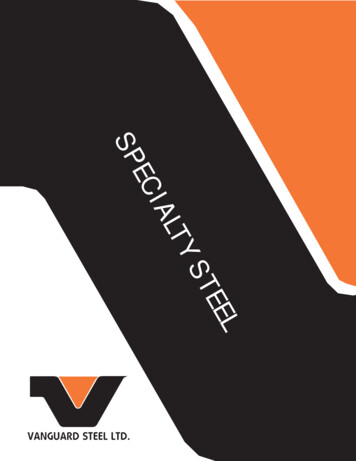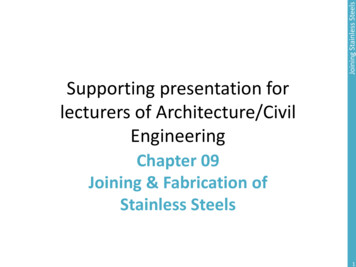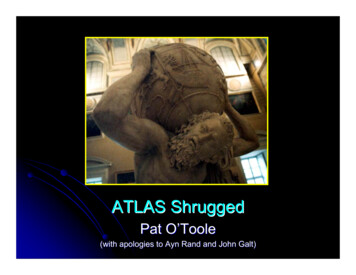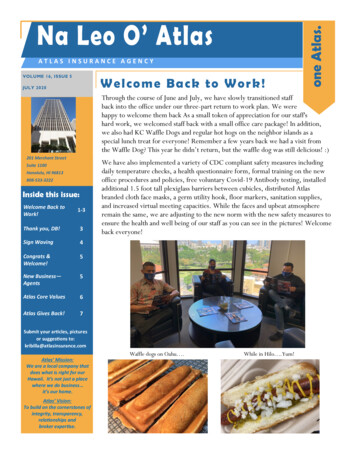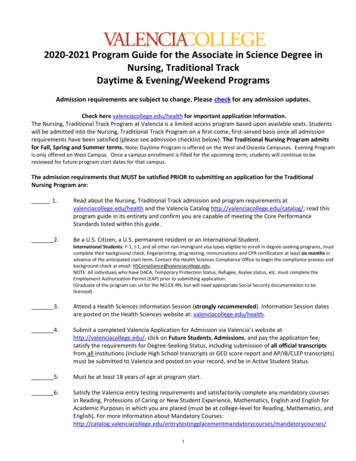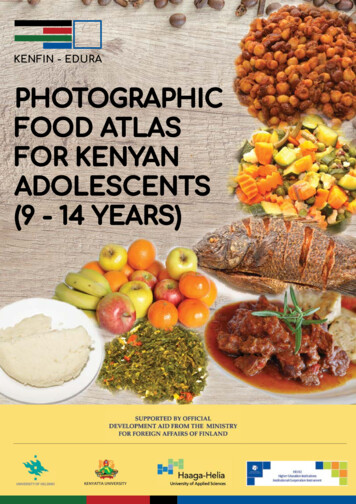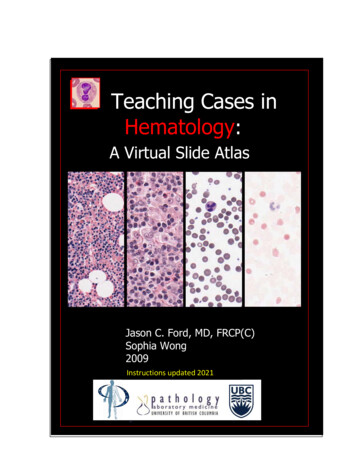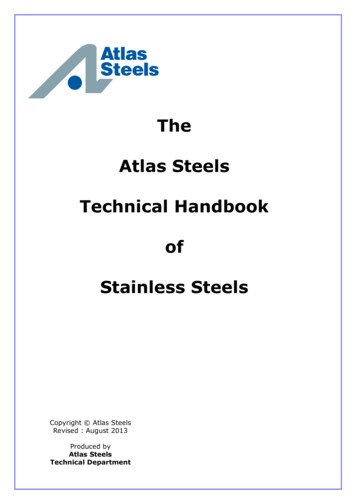
Transcription
TheAtlas SteelsTechnical HandbookofStainless SteelsCopyright Atlas SteelsRevised : August 2013Produced byAtlas SteelsTechnical Department
ATLAS STEELS Technical Handbook of Stainless SteelsFOREWORDThis Technical Handbook has been produced as an aid to all personnel of Atlas Steels, their customers and theengineering community generally. It is intended to be both background reading for technical seminars conductedby Atlas Steels Technical Department, and also as a source of ongoing reference data. Any suggestions forimprovements, additions or corrections would be very welcome; these should be directed to:Technical Manager, Atlas SteelsTelephone 61 3 8383 9863, email peter.moore@atlassteels.com.auCopies of this handbook can be downloaded from the Atlas Steels web site at www.atlassteels.com.au.Details of specific products are given in the Atlas Steels “Product Reference Manual”, the series of Atlas GradeData Sheets and in Atlas Technotes, as listed below; copies of all these can be viewed or downloaded from theAtlas Steels Website.Atlas Steels ive Sorting Tests for SteelsPitting & Crevice Corrosion of Stainless SteelsStainless Steels - Properties & Equivalent GradesMachining of Stainless SteelsCleaning, Care & Maintenance of Stainless SteelsLife Cycle CostingGalvanic Corrosion"L", "H" and Standard Grades of Stainless SteelsStainless Steel Tube for the Food IndustryRestrictions of Hazardous Substances (RoHS)Magnetic Response of Stainless SteelsPipe Dimensions“AtlasCR12” & “AtlasCR12Ti” – the 12% Chromium Ferritic Stainless SteelsAluminium Alloys 5052 and 5251 – Quite Similar but Completely DifferentAtlas Grade DatasheetsConcise datasheets, covering all the common stainless steels, include chemical composition, mechanical andphysical properties, fabrication and application of each grade. Again these are available from the AtlasSteels Website.Information from any Atlas publications can be freely copied, but it is requested that the source beacknowledged.Atlas Steels Technical DepartmentAtlas Steels Technical Department comprises experienced metallurgists, based at our Melbourne Head Office.We offer a free information service, including: Metal grade selection Fabrication information Special steels applications Specification assistance (such as equivalents of foreign specifications and trade names) Metallurgical properties of metals Supply of technical literature published by Atlas Steels and other metals institutions and bodies.We also have our own metallurgical laboratory providing facilities to assist in investigation of products andapplications.This assistance is provided as a free service to Atlas Steels' valued customers, and to all members of theAustralian and New Zealand engineering community.email tech@atlassteels.com.auLimitation of LiabilityThe information contained in this Technical Handbook is not an exhaustive statement of all relevant information. Itis a general guide for customers to the products and services available from Atlas Steels and no representation ismade or warranty given in relation to this information or the products or processes it describes.Published by Atlas Steels Technical DepartmentCopyright Atlas Steelswww.atlassteels.com.auPage 2
ATLAS STEELS Technical Handbook of Stainless SteelsTABLE OF CONTENTSFOREWORD2Atlas Steels TechnotesAtlas Grade DatasheetsAtlas Steels Technical DepartmentLimitation of Liability2222TABLE OF CONTENTS3THE FAMILY OF MATERIALS4Steel Grade Designations4STAINLESS STEELS - INTRODUCTION TOTHE GRADES AND FAMILIES6The Families of Stainless Steels6Austenitic Stainless Steels6Ferritic Stainless Steels7Martensitic Stainless Steels7Duplex Stainless Steels7Precipitation Hardening Stainless Steels 7Characteristics of Stainless Steels7Standard Classifications7Austenitic and Duplex Stainless Steels8Ferritic and Martensitic Stainless Steels9Comparative Properties of the Stainless SteelAlloy Families10CORROSION RESISTANCE11General CorrosionPitting corrosionCrevice corrosionStress corrosion cracking (SCC)Sulphide Stress Corrosion Cracking (SSC)Intergranular corrosionGalvanic corrosionContact corrosionHIGH TEMPERATURE RESISTANCE111112121313141416Scaling ResistanceCreep StrengthStructural StabilityEnvironmental FactorsThermal Expansion1616171717CRYOGENIC PROPERTIES19MAGNETIC PROPERTIES20Magnetically Soft Stainless SteelsMECHANICAL PROPERTIESMechanical Properties of WireMechanical Properties of BarFABRICATIONForming OperationsMachiningWeldingSoft SolderingBrazing ("Silver Soldering")HEAT TREATMENTAnnealingHardeningStress RelievingSurface Hardening303031SURFACE ishingGrinding and PolishingMechanical CleaningBlackening32323333333434SURFACE CONTAMINATION INFABRICATION35Contamination by Carbon SteelContamination by ChloridesContamination by Carbon353535DESIGN CONSIDERATIONS INFABRICATION OF STAINLESS STEELS36Grade Selection for Fabrication36Design to Avoid Corrosion36Specific Design Points - To Retain CorrosionResistance37GUIDELINES FOR STAINLESS STEEL GRADESELECTION39APPENDICES41Grade Summary - Stainless & Heat ResistingSteels41Comparison of Grade Specifications ofStainless Steels43Typical Physical Properties - AnnealedCondition44Hardness Conversions45Unit Conversions46Dimensional Tolerances for Bar47Further Information48Internet Sites of com.auPage 3
ATLAS STEELS Technical Handbook of Stainless SteelsTHE FAMILY OF MATERIALSMaterials can be divided into metals and nonmetals; the history of civilisation has largely beencategorised by the ability to work metals - hence"bronze age" and "iron age" - but until quiterecently most large-scale construction was still innon-metals, mostly stone or masonry and wood.Today a vast number of materials compete fortheir share of the market, with more newmaterials being added every year. Someparticularly exciting developments are nowoccurring in the fields of ceramics, plastics andglasses and composites of these materials. Theday of the ceramic car engine is probably not allthat far off - already there are some hightemperature components made from the newgeneration of tougher ceramics, and the modernmotor vehicle also offers many examples of theuse of engineering plastics. Recent developmentsin metals have re-asserted their competitiveposition in auto engineering, in particular the useof aluminium and magnesium alloys. A majorrevolution under way at present is thereplacement of much copper telecommunicationscabling with glass optical fibre. For metals tocompete they must be able to demonstratesuperior properties to their splaincarbonsteels10200.2% Cbridges,buildingframes,machineryshaftslow alloysteels41400.4% C1.0% Cr0.2% nless& highalloysteels3040.05% C18% Cr9% Nicorrosionresistanttanks, bolts,springstoolsteelsH130.4% C1.05% Si5.2% Cr1.3% Mo1.0% Vtools forcasting andhot forgingIn a similar fashion each of the metals has tocompete for its market share, based ondemonstrated superiority of properties oreconomics. It is therefore worth identifying thevarious metals available and indicating just whattheir most important features are. A basicdifferentiation is to divide metals into "ferrous"and "non-ferrous", ie those iron-based and all theothers.Amongst the non-ferrous metals the mostimportant for engineering applications are thefamilies of aluminium alloys (with very lowdensities, high electrical and thermal conductivity,good formability and good corrosion resistancethese find applications in aircraft, high tensionelectricity conductors, yacht masts etc) and ofcopper alloys (with very high electrical andthermal conductivities and ready formability thesefind their principal applications in electrical wiring).Other important non-ferrous alloys (an alloy issimply a mixture of two or more metals) are thebrasses and bronzes.The family of ferrous metals incorporates a vastnumber of alloys. Those alloys containing a veryhigh proportion of carbon (over about 2%) arecalled cast irons. Virtually all of the remainder aretermed steels and these can be found in eithercast form (produced by pouring molten metal intoa mould of the shape of the finished part) orwrought form (cast as ingots or continuous castbillets or slabs, but then hot rolled or forged toproduce bars, plates or complex shapes such asrail sections and beams). They can also be formedto finished shape by sintering powdered metal athigh temperature. Steels are categorised by theirmajor alloying elements (carbon, manganese,chromium, nickel and molybdenum) and by thepresence or absence of minor elements (silicon,sulphur, phosphorus, nitrogen and titanium), asshown in the table in Figure 1."Micro" additions of alloys are also present in somegrades.Atlas Steels distributes product from all fourcategories (plain carbon, low alloy, stainless andtool steels).Steel Grade DesignationsFigure 1 Typical grades in each steel groupDesignation systems for metals vary widely. In thepast every producer had their own name for eachgrade they produced - some examples were"Duraflex" (BHP's name for 1045) and "Sixix"(Atlas Steels Canada's name for M2 high speedsteel).Thankfully this practice is now reducing, withbenefits to all users. In some instances there isjustification for the use of a specific trade name,for instance where a manufacturer has made awww.atlassteels.com.auPage 4
ATLAS STEELS Technical Handbook of Stainless Steelsgrade significantly different from other similarproducts. This is particularly appropriate in newproduct areas such as duplex stainless steels,where national standards lag behind commercialalloy development, and where grades are stillevolving. Some producers, however, cling to theuse of trade names for quite standard grades inthe hope of generating sales on the basis ofperceived rather than actual product superiority.Apart from trade designations a variety of namingsystems exist, supported by one or otherstandards body. In Australia metals designationstend to more or less follow those of the USA principally the American Iron and Steel Institute(AISI) and American Society for Testing andMaterials (ASTM). These bodies many years agodeveloped three-digit designations for stainlesssteels, four-digit designations for carbon and lowalloy steels and one letter plus one or two digitdesignations for tool steels. All three systems haveproven inadequate for coping with an on-goingseries of new alloy developments, so a new UnifiedNumbering System (UNS) has been implementedby ASTM and the Society of Automotive Engineers(SAE). The UNS designations have been allocatedto all metals in commercial production, throughoutthe world; a single letter indicates the alloy family(N nickel base alloys, S stainless steels, etc)and five digits denote the grade. This system isnow incorporated in all ASTM standards, and alsosome standards from other countries such asAustralia.Japanese grade designations are based on theAISI/ASTM designations as far as stainless steelsare concerned, with some modifications andexceptions. They follow their own system for othersteels.Until recent years British Standards had adesignation system for steel grades based uponthe AISI/ASTM system, but with extra digits tospecify slight variants of grades, eg 316S31 was aparticular variant of Grade 316 stainless steel.Other European national standards were quitedifferent, and also differed among themselves. Themost commonly encountered system was theGerman Werkstoff (Workshop) Number giving allsteels a single digit plus four digit designation, eg"1.4301" for Grade 304. A second identifierassociated with each grade is the DIN designation,eg "X 5 CrNi 18 9" for Grade 304.In addition to these national specifications thereare International Standards (ISO) which tend tofollow various European systems, and a newlydeveloping set of "Euronorm" (EN) Europeanspecifications from the European Union. TheseEuronorms have now largely replaced nationalspecifications from Britain, Germany, France andother member nations. For stainless steels themost common grade designation system inAustralia and New Zealand is that of the AmericanASTM. There is however increased awareness ofthe Euronorm system.An interesting development in 2006 was the minorrevision of composition limits for grade 304 flatrolled product in ASTM A240 with the specific aimof harmonizing it with the European equivalentgrade 1.4301. There is a long way to go, butperhaps this is the beginning of a truly uniformworld-wide agreement on specifications.Numerous cross references between grades arepublished; a very comprehensive publication is theGerman "Stahlschlüssel" (Key to Steel). This isparticularly good for German specifications butdoes cover all significant steel specifying countries,including Australia, and lists trade names inaddition to national specifications. Several websites also give specification comparisons.A summary of these grade equivalents (or nearalternatives) is shown in Appendix 2.www.atlassteels.com.auPage 5
ATLAS STEELS Technical Handbook of Stainless SteelsSTAINLESS STEELS - INTRODUCTION TO THE GRADES AND FAMILIESThe group of alloys which today make up thefamily of stainless steels had their beginning in theyears 1900 to 1915. Over this period researchwork was published by metallurgists in France andGermany on ferritic, martensitic and austeniticstainless steels. Commercialisation began in theyears 1910 to 1915, with the Americans Dansitzenand Becket’s work on ferritic steels and Maurerand Strauss developing austenitic grades inGermany. The often-related development ofmartensitic steels was in 1913 in Sheffield,England; Harry Brearley was trying a number ofalloys as possible gun barrel steels, and noticedthat samples cut from one of these trial Heats didnot rust and were in fact difficult to etch. When heinvestigated this curious material - it containedabout 13% chromium - it lead to the developmentof the stainless cutlery steels for which Sheffieldbecame famous.Although the consumption of stainless steels isgrowing very rapidly around the world (average of5.8% per annum in the Western world over theperiod 1950 to 2001) average per capitaconsumption in Australia is very low bycomparison with other developed, and manydeveloping countries. In 1999 Australians eachconsumed about 5kg, compared with about 8kgper head in France, 13kg in Japan, 16kg inGermany, 26kg in Singapore and 38kg in Taiwan.On average each Chinese consumed about 1.3kg,but this figure is rapidly rising.The Families of Stainless SteelsStainless steels are iron based alloys containing aminimum of about 10.5% chromium; this forms aprotective self-healing oxide film, which is thereason why this group of steels have tance. The ability of the oxide layer to healitself means that the steel is corrosion resistant,no matter how much of the surface is removed;this is not the case when carbon or low alloy steelsare protected from corrosion by metallic coatingssuch as zinc or cadmium or by organic coatingssuch as paint.Although all stainless steels depend on thepresence of chromium, other alloying elements areoften added to enhance their properties. Thecategorisation of stainless steels is unusualamongst metals in that it is based upon the natureof their metallurgical structure - the terms useddenote the arrangement of the atoms which makeup the grains of the steel, and which can beobserved when a polished section through a pieceof the material is viewed at high magnificationthrough a microscope. Depending upon the e may be made up of the stablephases austenite or ferrite, a "duplex" mix of theseFigure 2 Families of stainless steelsthese two, the phase martensite created whensome steels are rapidly quenched from a hightemperature, or a structure hardened byprecipitated micro-constituents.The relationship between the different families isas shown in Figure 2. A broad brush comparison ofthe properties of the different families is given inFigure 5.Austenitic Stainless SteelsThis group contain at least 16% chromium and 6%nickel (the basic grade 304 is sometimes referredto as 18/8) and range through to the high alloy or"super austenitics" such as 904L and 6%molybdenum grades.Additional elements can be added such asmolybdenum, titanium or copper, to modify orimprove their properties, making them suitable e as well as corrosion resistance. Thisgroup of steels is also suitable for cryogenicapplications because the effect of the nickelcontent in making the steel austenitic avoids theproblems of brittleness at low temperatures, whichis a characteristic of other types of steel.The relationship between the various austeniticgrades is shown in Figures 3.www.atlassteels.com.auPage 6
ATLAS STEELS Technical Handbook of Stainless SteelsFerritic Stainless Steelscauses no distortion of the component.These are plain chromium (10½ to 29%) gradessuch as Grades 430 and 409. Their moderatecorrosion resistance and poor fabricationproperties are improved in the higher alloyed andstabilised grades such as 439 and 444 and in theproprietary grade AtlasCR12.The relationship between the various ferriticgrades is shown in Figure 4.Martensitic Stainless SteelsMartensitic stainless steels are also based on theaddition of chromium as the major alloyingelement but with a higher carbon and generallylower chromium content (eg 12% in Grades 410and 416) than the ferritic types; Grade 431 has achromium content of about 16%, but themicrostructure is still martensite despite this highchromium level because this grade also contains2% nickel.Characteristics of StainlessSteelsThe characteristics of the broad group of stainlesssteels can be viewed as compared to the morefamiliar plain carbon "mild" steels. As ageneralisation the stainless steels have: Higher work hardening rate Higher ductility Higher strength and hardness Higher hot strength Higher corrosion resistance Higher cryogenic toughness Lower magnetic response (austenitic only)These properties apply particularly to theaustenitic family and to varying degrees to othergrades and families.The relationship between the various martensiticgrades is shown in Figure 4.These properties have implications for the likelyfields of application for stainless steels, but alsoinfluence the choice of fabrication methods andequipment.Duplex Stainless SteelsStandard ClassificationsDuplex stainless steels such as 2205 and 2507(these designations indicate compositions of 22%chromium, 5% nickel and 25% chromium, 7%nickel but both grades contain further ng a mixture of austenite and ferrite.Duplex ferritic - austenitic steels combine some ofthe features of each class: they are resistant tostress corrosion cracking, albeit not quite asresistant as the ferritic steels; their toughness issuperior to that of the ferritic steels but inferior tothat of the austenitic steels, and their strength isgreater than that of the (annealed) austeniticsteels, by a factor of about two. In addition theduplex steels have general corrosion resistancesequal to or better than 304 and 316, and ingeneral their pitting corrosion resistances aresuperior to 316. They suffer reduced toughnessbelow about -50oC and after exposure above300oC, so are only used between thesetemperatures.There are many different varieties of stainlesssteel and the American Iron and Steel Institute(AISI) in the past designated some as standardcompositions, resulting in the commonly usedthree digit numbering system. This role has nowbeen taken over by the SAE and ASTM, whoallocate 1-letter 5-digit UNS numbers to newgrades. The full range of these standard stainlesssteels is contained in the Iron and Steel Society(ISS) "Steel Products Manual for Stainless Steels",and in the SAE/ASTM handbook of UnifiedNumbering System. Certain other grades do nothave standard numbers, but are instead coveredby other national or international specifications, orby specifications for specialised products such asstandards for welding wire. The following diagramsshow most of the grades of stainless steelsdistributed by Atlas Steels and also some otherimportant grades, identified by their gradenumbers or common designations, illustratingsome of the important properties of the variousfamilies of grades.The relationship between the various duplexgrades is shown in Figures 3.Precipitation Hardening Stainless SteelsThese are chromium and nickel containing steelswhich can develop very high tensile strengths. Themost common grade in this group is "17-4 PH";also known as Grade 630, with the composition of17% chromium, 4% nickel, 4% copper and 0.3%niobium. The great advantage of these steels isthat they can be supplied in the "solution treated"condition; in this condition the steel is justmachinable. Following machining, forming etc. thesteel can be hardened by a single, fairly lowtemperature "ageing" heat treatment which causeswww.atlassteels.com.auPage 7
ATLAS STEELS Technical Handbook of Stainless SteelsAustenitic and Duplex Stainless SteelsAustenitic Stainless Steel304Basic GradeIncreasing high temperature resistance 253MAS30815310Increasing corrosion resistance 317316LWeld stabilized grades304L321Weld stabilized grades308L347Welding consumable grades303Free Machining grade302HQ904L6MoS31254316Low work hardening rate for cold headingDuplex Stainless Steels2304S323042250S31803super duplexgradesFigure 3 The families of Austenitic and Duplex Stainless Steelswww.atlassteels.com.auPage 8
ATLAS STEELS Technical Handbook of Stainless SteelsFerritic and Martensitic Stainless SteelsFerritic Stainless Steels430basic grade444409430FHigher corrosion resisting weldable grade.3CR12Utility grades with increasingtoughness Free machining gradeMartensitic Stainless Steels410basic grade420Higher hardness grade431Higher corrosion resistanceand higher toughness gradeIncreasing hardness after heat treatment 440A416440B440CFree machining gradeFigure 4 The families of Ferritic and Martensitic Stainless Steelswww.atlassteels.com.auPage 9
ATLAS STEELS Technical Handbook of Stainless SteelsComparative Properties of the Stainless Steel Alloy FamiliesAlloy GroupMagneticResponse(note ureResistance(note 3)WeldabilityAusteniticGenerally NoVery HighHighBy Cold WorkVery HighVery HighVery HighVery HighDuplexYesMediumVery MediumHighLowLow to HighMartensiticYesMediumMediumQuench MediumAge HardeningMediumLowLowHighNotes1.2.3.Attraction of the steel to a magnet. Note some austenitic grades can be attracted to a magnet if cold worked, cast or welded.Varies significantly between grades within each group. e.g. free machining grades have lower corrosion resistances, those grades higher in chromium,molybdenum and nitrogen have higher resistances. Corrosion resistance is not primary related to the alloy group (structure) but more by the composition.Measured by toughness or ductility at sub-zero temperatures. Austenitic grades retain ductility to cryogenic temperatures.Figure 5 Comparative propertieswww.atlassteels.com.auPage 10
ATLAS STEELS Technical Handbook of Stainless SteelsCORROSION RESISTANCEAlthough the main reasons why stainless steels areused is corrosion resistance, they do in fact sufferfrom certain types of corrosion in someenvironments and care must be taken to select agrade which will be suitable for the application.Corrosion can cause a variety of problems,depending on the applications:Tables of resistance to various chemicals arepublished by various organisations and a verylarge collection of charts, lists, recommendationsand technical papers is available through the AtlasSteels Technical Services Department.Perforation such as of tanks and pipes, whichallows leakage of fluids or gases,Loss of strength where the cross section ofstructural members is reduced by corrosion,leading to a loss of strength of the structureand subsequent failure,Degradation of appearance, where corrosionproducts or pitting can detract from adecorative surface finish,Finally, corrosion can produce scale or rustwhich can contaminate the material beinghandled; this particularly applies in the case offood processing equipment.Under certain conditions, particularly involvinghigh concentrations of chlorides (such as sodiumchloride in sea water), moderately hightemperatures and exacerbated by low pH (ie acidicconditions), very localised corrosion can occurleading to perforation of pipes and fittings etc.This is not related to published corrosion data as itis an extremely localised and severe corrosionwhich can penetrate right through the crosssection of the component. Grades high inchromium, and particularly molybdenum andnitrogen, are more resistant to pitting corrosion. Corrosion of stainless steels can be categorisedas:General CorrosionPitting CorrosionCrevice CorrosionStress Corrosion CrackingSulphide Stress Corrosion CrackingIntergranular CorrosionGalvanic CorrosionContact CorrosionGeneral CorrosionCorrosion whereby there is a general uniformremoval of material, by dissolution, eg whenstainless steel is used in chemical plant forcontaining strong acids. Design in this instance isbased on published data to predict the life of thecomponent.Figure 6 Iso-corrosion curves forvarious stainless steels in sulphuricacidPublished data list the removal of metal over ayear - a typical example is shown in Figure 6.Pitting corrosionThe Pitting Resistance Equivalent number (PRE)has been found to give a good indication of thepitting resistance of stainless steels. The PRE canbe calculated as:PRE %Cr 3.3 x %Mo 16 x %NOne reason why pitting corrosion is so serious isthat once a pit is initiated there is a strongtendency for it to continue to grow, even althoughthe majority of the surrounding steel is stilluntouched.The tendency for a particular steel to be attackedby pitting corrosion can be evaluated in thelaboratory. A number of standard tests have beendevised, the most common of which is that givenin ASTM G48. A graph can be drawn giving thetemperature at which pitting corrosion is likely tooccur, as shown in Figure 7.Figure 7 Critical pitting temperaturesfor different alloys, rated by ASTMG48A testThe graph is based on a standard ferric chloridelaboratory test, but does predict outcomes inwww.atlassteels.com.auPage 11
ATLAS STEELS Technical Handbook of Stainless SteelsStress corrosion cracking (SCC)many service conditions.A very common corrosive environment in whichstainless steels are used is marine, generally up toa few hundred metres from quiet (eg: bay) water,or up to a few kilometres from a shore withbreaking waves. Corrosion in this environment issometimes called “tea staining” a term used byASSDA (Australian Stainless Steel DevelopmentAssociation) to describe light surface rusting,usually visible as a fairly wide-spread brown-reddiscolouration. A very full description of thecauses and prevention of tea staining is given inthe ASSDA Technical Bulletin on the For many years 316 has been regarded as the“marine grade” of stainless steel. It must berecognised however, that in the more aggressivemarine environments 316 will not fully resistpitting corrosion or tea staining. It has been foundthat finer surface finishes – generally with an Ravalue of no coarser than 0.5µm will assist inrestricting tea staining. It is also important thatthe surface is free of any contaminants.Crevice corrosionThe corrosion resistance of a stainless steel isdependent on the presence of a protective oxidelayer on its surface, but it is possible under certainconditions for this oxide layer to break down, forexample in reducing acids, or in some types ofcombustion where the atmosphere is reducing.Areas where the oxide layer can break down canalso sometimes be the result of the waycomponents are designed, for example undergaskets, in sharp re-entrant corners or associatedwith incomplete weld penetration or overlappingsurfaces. These can all form crevices which canpromote corrosion.To function as a corrosion site, a crevice has to beof sufficient width to permit entry of the corrodent,but sufficiently narrow to ensure that thecorrodent remains stagnant. Accordingly crevicecorrosion usually occurs in gaps a few micrometreswide, and is not found in grooves or slots in whichcirculation of the corrodent is possible. Thisproblem can often be overcome by payingattention to the design of the component, inparticular to avoiding formation of crevices or atleast keeping them as open as possible.Crevice corrosion is a very similar mechanism topitting corrosion; alloys resistant to one aregenerally resistant to both. Crevice corrosion canbe viewed as a more severe form of pittingcorrosion as it will occur at significantly lowertemperatures than does pitting. Further details ofpitting and crevice corrosion are given in AtlasTechnote 2.Under the combined effects of stress and certaincorrosive environments stainless steels can besubject to this very rapid and severe form ofcorrosion. The stresses must be tensile and canresult from loads applied in service, or stresses setup by the type of assembly e.g. interference fits ofpins in holes, or from residual stresses resultingfrom the method of fabrication such as coldworking. The most damaging environment is asolution of chlorides in water such as sea water,particularly at elevated temperatures. As aconsequence many stainless steels are limited intheir application for holding hot waters
Details of specific products are given in the Atlas Steels “Product Reference Manual”, the series of Atlas Grade Data Sheets and in Atlas Technotes, as listed below; copies of all these can be viewed or downloaded from the Atlas Steels Website. Atlas St
